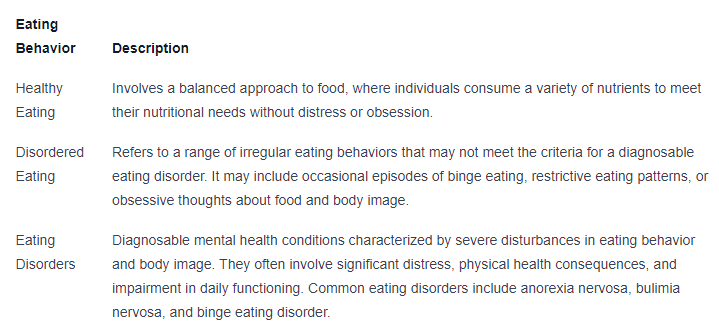Difference Between Disordered Eating and Eating Disorders

Understanding Eating Behavior
When it comes to our relationship with food, eating behavior is a complex and multifaceted aspect of human life. It encompasses a wide range of attitudes, emotions, and actions related to food and eating. Understanding the nuances of eating behavior is essential in distinguishing between disordered eating and eating disorders.
The Complexity of Eating Behavior
Eating behavior involves various factors, including biological, psychological, social, and cultural influences. It encompasses not only our physiological need for sustenance but also our emotions, beliefs, and behaviors surrounding food. Eating behavior is shaped by a combination of genetic predispositions, environmental factors, and individual experiences.
The Spectrum of Eating Issues
Within the realm of eating behavior, there exists a spectrum of issues that individuals may experience. This spectrum ranges from healthy eating patterns to disordered eating and eating disorders. It's important to recognize that disordered eating and eating disorders exist on a continuum and can exhibit overlapping characteristics.
To better understand this spectrum, consider the following:

Understanding the complexity and spectrum of eating behavior is crucial in distinguishing between disordered eating and eating disorders. While disordered eating may exhibit some similarities to eating disorders, it is important to recognize the key differences between the two.
Disordered Eating Defined
When it comes to understanding eating behaviors, it's important to distinguish between disordered eating and eating disorders. Disordered eating refers to a range of irregular eating behaviors that may not meet the criteria for a specific eating disorder. In this section, we will explore what disordered eating entails and highlight its defining characteristics.
What is Disordered Eating?
Disordered eating can be defined as a disorganized or abnormal pattern of eating habits that deviates from what is considered typical or healthy. It involves a disturbed relationship with food and body image, often leading to negative physical and psychological consequences.
Unlike eating disorders, which are diagnosed mental health conditions, disordered eating falls on a spectrum and can manifest in various ways. It may include behaviors such as restrictive eating, excessive calorie counting, obsessive food rituals, or cycles of dieting and bingeing.
Characteristics of Disordered Eating
Disordered eating is characterized by several key features. These behaviors and patterns can vary in severity and intensity, and they may fluctuate over time. Some common characteristics of disordered eating include:
- Preoccupation with food: Individuals with disordered eating often have an excessive amount of time and mental energy focused on food, including thoughts about calories, weight, and body shape.
- Strict dietary rules: Following strict and rigid dietary rules is a hallmark of disordered eating. This can involve eliminating entire food groups, severely restricting calorie intake, or engaging in extreme dieting practices.
- Unhealthy weight control behaviors: Disordered eating may involve the use of unhealthy weight control methods such as fasting, excessive exercise, or self-induced vomiting. These behaviors are often driven by a desire to achieve or maintain a specific body shape or weight.
- Negative body image: Individuals with disordered eating often have a distorted perception of their body image and may engage in body comparison or experience dissatisfaction with their appearance.
- Emotional distress: Disordered eating is often associated with emotional distress, including feelings of guilt, shame, or anxiety related to food and eating. This can contribute to a cycle of disordered eating behaviors.
It's important to note that while disordered eating behaviors can significantly impact an individual's overall well-being, they may not meet the diagnostic criteria for a specific eating disorder. However, disordered eating behaviors can be a precursor to the development of an eating disorder if left unaddressed.
By understanding the distinction between disordered eating and eating disorders, individuals and healthcare professionals can better identify and address these behaviors, and provide appropriate support and treatment to those in need.
Eating Disorders Defined
When it comes to understanding eating behavior and its complexities, it's important to have a clear understanding of eating disorders. Eating disorders are serious mental health conditions that can have severe consequences on both physical and mental well-being. In this section, we will explore what eating disorders are and the different types that exist.
What are Eating Disorders?
Eating disorders are characterized by abnormal eating habits and a distorted perception of body weight and shape. They involve a range of behaviors and emotions related to food, weight, and body image. Individuals with eating disorders often experience intense fear of gaining weight, obsession with food, and a preoccupation with body shape and size. These disorders can significantly impact a person's overall health and quality of life.
Different Types of Eating Disorders
There are several recognized types of eating disorders, each with its own distinct characteristics. The most common types include:

Understanding the different types of eating disorders is crucial for recognizing the signs and symptoms in oneself or others. While each eating disorder has its own unique features, they all share a common thread of disrupted eating patterns and negative impacts on physical and mental health. Seeking professional help and support is essential for individuals struggling with eating disorders to ensure proper diagnosis, treatment, and recovery.
Key Differences between Disordered Eating and Eating Disorders
When it comes to understanding eating behavior, it's important to unravel the distinction between disordered eating and eating disorders. While these terms are often used interchangeably, they represent different levels of severity and impact on an individual's physical and mental health. Let's explore the key differences between disordered eating and eating disorders.
Severity and Intensity
One of the main differences between disordered eating and eating disorders lies in the severity and intensity of the behaviors exhibited. Disordered eating refers to a range of irregular eating behaviors that may not meet the diagnostic criteria for a specific eating disorder. These behaviors can include occasional restrictive eating, binge eating, or excessive exercise.
On the other hand, eating disorders are diagnosed mental health conditions characterized by severe disturbances in eating behaviors and body image. They often involve intense fear of weight gain or obsession with body weight and shape. Eating disorders such as anorexia nervosa, bulimia nervosa, and binge eating disorder are more severe in nature and require professional intervention for diagnosis and treatment.
Frequency and Duration
The frequency and duration of disordered eating behaviors versus eating disorders also differ significantly. Disordered eating behaviors may occur sporadically or in response to certain triggers, such as stress or social situations. These behaviors may not persist over an extended period and may not significantly disrupt daily life.
In contrast, eating disorders involve persistent and chronic patterns of disordered eating that can last for months or even years. These behaviors often become ingrained and are associated with rigid rules around food and eating. They can severely impact an individual's ability to function in various aspects of life, including relationships, work, and social activities.
Impact on Physical and Mental Health
Both disordered eating and eating disorders can have negative impacts on physical and mental health, but the severity of these impacts differs. Disordered eating behaviors, if infrequent and short-lived, may have minimal long-term effects on physical health. However, they can still contribute to feelings of guilt, shame, and dissatisfaction with one's body image.
In contrast, eating disorders can have severe physical and mental health consequences. Prolonged restriction of food intake in anorexia nervosa can lead to significant weight loss, nutrient deficiencies, and organ damage. Bulimia nervosa, characterized by cycles of binge eating and purging, can cause electrolyte imbalances, dental problems, and gastrointestinal issues. Binge eating disorder can lead to weight gain, obesity, and related health complications.
It's important to note that while disordered eating behaviors may not meet the criteria for an eating disorder, they can still be a risk factor for developing an eating disorder in the future. Seeking early intervention and support is crucial to address disordered eating and prevent the progression to a more severe eating disorder.
Understanding the differences between disordered eating and eating disorders can help individuals and healthcare professionals identify and address these issues effectively. By promoting awareness, education, and early intervention, we can support individuals in their journey towards a healthier relationship with food and body image.
Seeking Support and Treatment
When it comes to disordered eating and eating disorders, seeking appropriate support and treatment is crucial for recovery and overall well-being. Recognizing the need for help, accessing professional assistance and resources, and embracing early intervention are important steps in the journey towards healing.
Recognizing the Need for Help
Recognizing that one may be struggling with disordered eating or an eating disorder can be challenging, as individuals may feel ashamed, embarrassed, or in denial about their behaviors or thoughts surrounding food and body image. However, it is important to acknowledge the signs and symptoms that indicate the need for help.
Some common signs that may indicate the need for support and treatment include:
- Persistent and excessive preoccupation with food, body weight, or shape
- Frequent and extreme dieting or restrictive eating patterns
- Frequent episodes of binge eating or purging behaviors
- Significant weight fluctuations or changes in eating habits
- Negative self-image and distorted body perception
- Emotional distress or feelings of guilt and shame related to eating
- Withdrawal from social activities and relationships due to food and body concerns
If you or someone you know is experiencing these symptoms, it is important to reach out for assistance and support.
Professional Help and Resources
Seeking professional help is essential for effectively addressing disordered eating and eating disorders. A multidisciplinary approach involving healthcare professionals, therapists, nutritionists, and support groups can provide comprehensive support and guidance throughout the recovery process.
Some of the professionals and resources that can be helpful include:

It is important to consult with healthcare professionals experienced in eating disorders to ensure accurate diagnosis and appropriate treatment options.
Importance of Early Intervention
Early intervention plays a critical role in the successful treatment of disordered eating and eating disorders. Recognizing the signs and seeking help promptly can prevent the condition from worsening and mitigate potential long-term physical and psychological consequences.
By addressing disordered eating or an eating disorder early on, individuals can benefit from:
- Increased chances of recovery and improved overall well-being
- Minimized physical health complications, such as nutrient deficiencies or organ damage
- Reduced risk of developing severe or chronic eating disorders
- Enhanced psychological and emotional well-being
- Improved quality of life and relationships
Remember, seeking support and treatment is not a sign of weakness but a courageous step towards healing and reclaiming a healthier relationship with food and oneself. Reach out to professionals and utilize available resources to embark on a journey of recovery and self-discovery.
Conclusion
Eating disorders and disordered eating behaviors are complex and multifaceted issues that require attention, support, and treatment. By understanding the key differences between these two concepts, recognizing the signs and symptoms, and seeking appropriate professional help, individuals can take positive steps towards recovery and healing.
It's important to remember that disordered eating behaviors can be a precursor to developing an eating disorder if left untreated. Therefore, early intervention is crucial for addressing these behaviors before they escalate. With proper support and resources, individuals can learn to develop a healthier relationship with food and their body image.
While recovery may be challenging, it is possible. By embracing self-compassion, cultivating a positive support system, and accessing the necessary resources, individuals can reclaim their lives from the grips of disordered eating or an eating disorder.
Remember that every individual's journey towards recovery is unique and personal. It's essential to seek out the help that aligns with one's individual needs and preferences. By working together as a community to promote awareness, education, and access to resources for disordered eating and eating disorders, we can collectively create a more supportive environment for all those impacted by these conditions.
